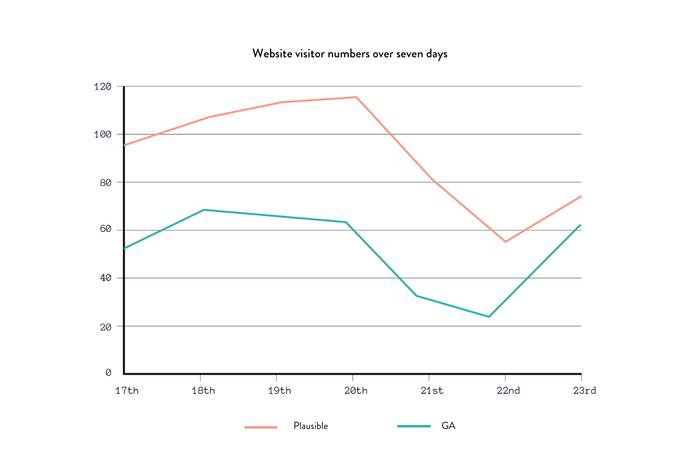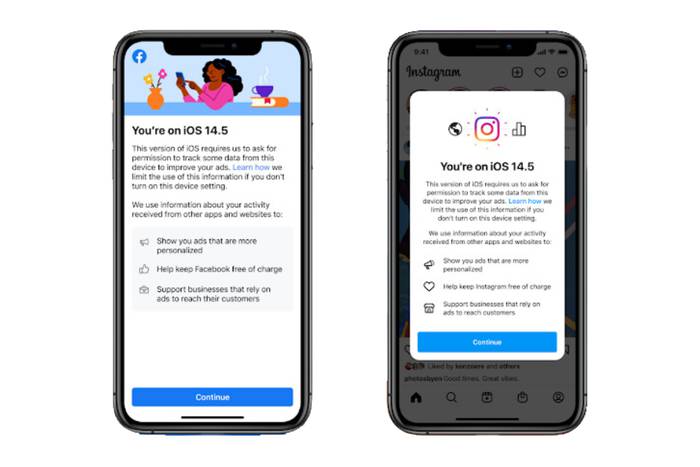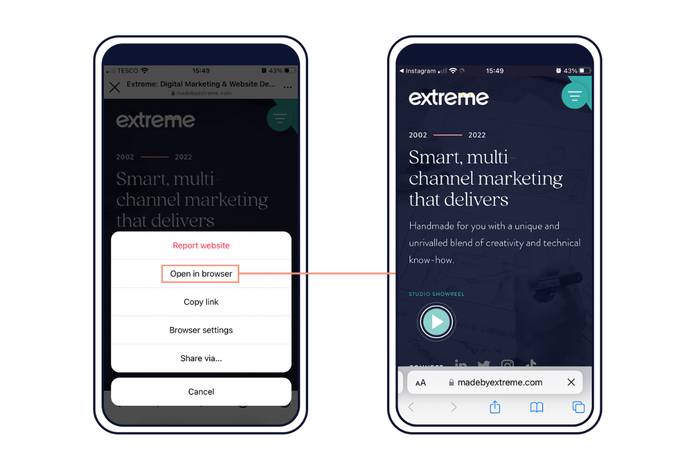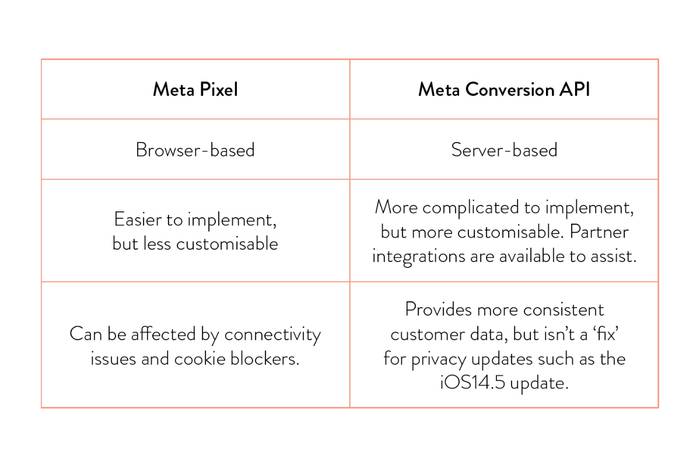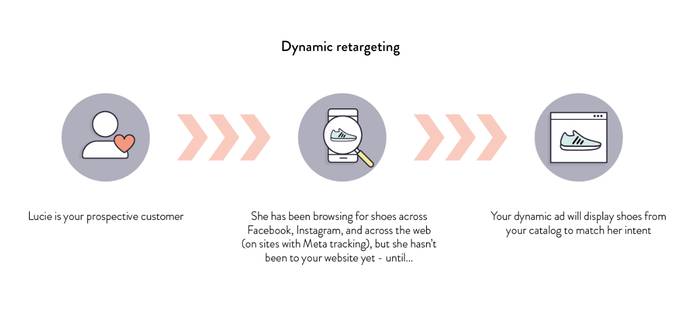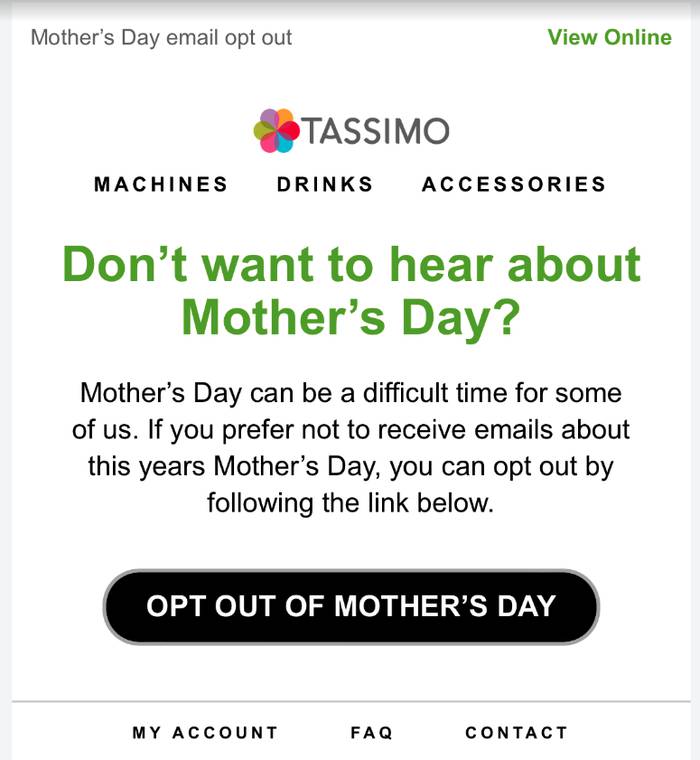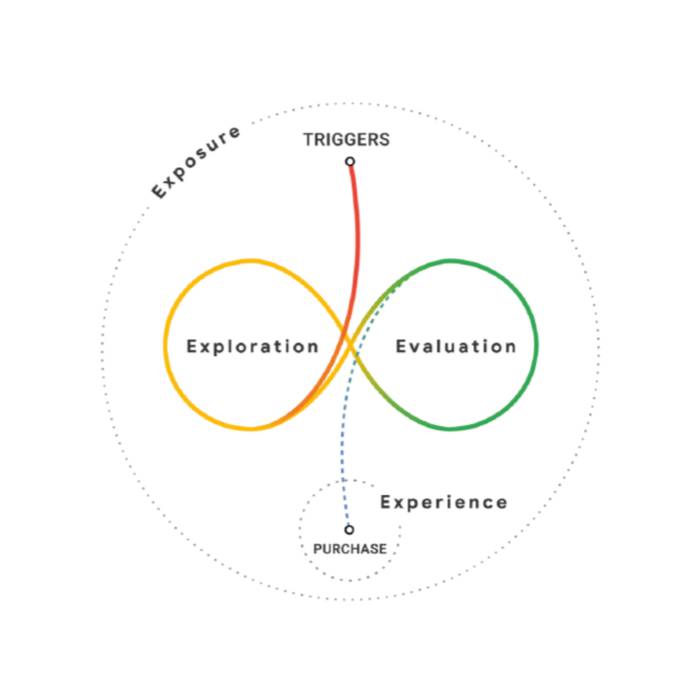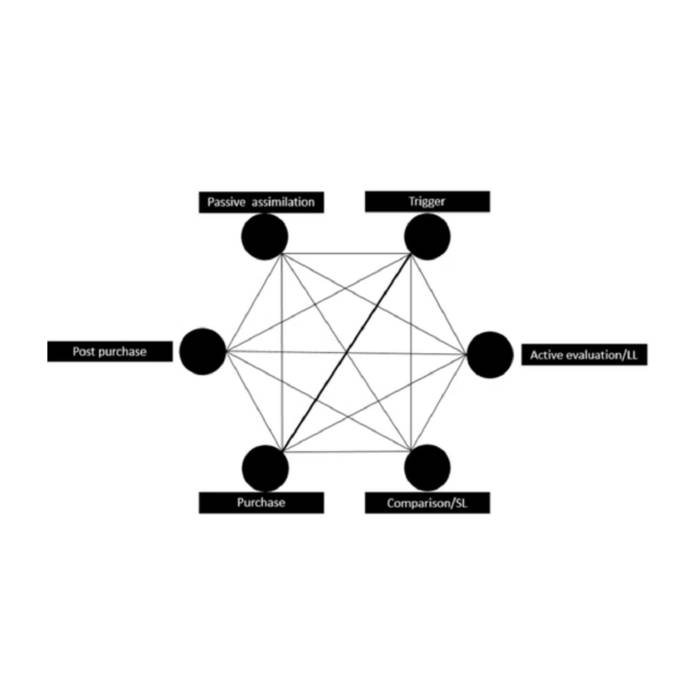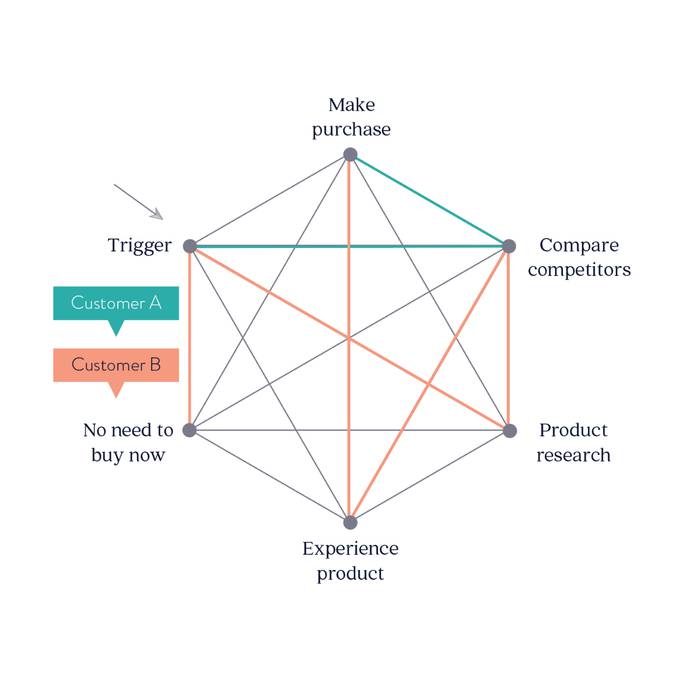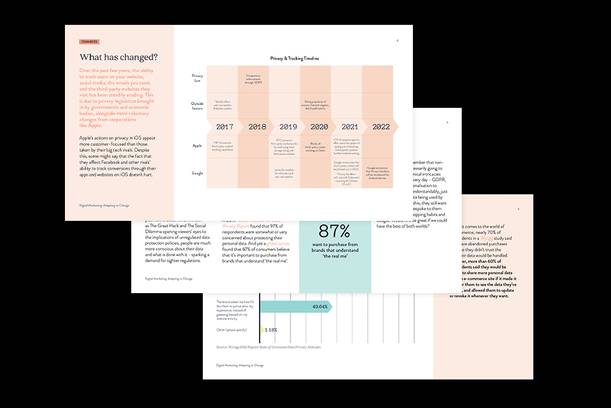
What you'll find below...
Part 1: Privacy and tracking changes
What, why and how?
Part 2: A deep dive into privacy
Understanding Google and iOS changes.
Part 3: How to keep targeting & tracking
Turning restrictions into opportunities.
Part 4: Path to purchase in the new world
Introducing the messy hexagon.
Part 5: The future of marketing...
What we’ve learned.

Part 1: Privacy and tracking changes
What are they, why they have come about and what are the alternative opportunities available to marketers?
Privacy and tracking: what has changed?
Over the past few years, the ability to track users on your website, social media, the emails you send, and the third-party websites they visit has been steadily eroding. This is due to privacy legislation brought in by governments and economic bodies, alongside more voluntary changes from corporations like Apple.
Apple’s actions on privacy in iOS appear more customer-focused than those taken by their big tech rivals. Despite this, some might say that the fact that they affect Facebook and other rivals’ ability to track conversions through their apps and websites on iOS doesn’t hurt.
“63% of consumers worldwide think companies aren’t honest about how they use their personal information.”
63% of consumers worldwide think companies aren’t honest about how they use their personal information, and nearly 48% have stopped purchasing from companies because of privacy worries.
A major obstacle marketers across all industries are now having to tackle is balancing customers opting for increased privacy settings, limiting how much data we can access, while still expecting brands and marketers to provide relevant advertising.
It’s important to remember that nonmarketers aren’t necessarily going to understand the technical intricacies that we encounter every day - GDPR, cookies, cache, personalisation to name a few - they, understandably, just see their personal data being used by companies.
Despite this, they still want to see tailored ads, bespoke to them and their lifestyle, shopping habits and budget. Wouldn’t it be great if we could have the best of both worlds?
“48% have stopped purchasing from companies because of privacy worries”
Consumers, consent and declining conversions
Possibly the most impactful changes to UK and EU businesses have been caused by the GDPR cookie directives.
This means that tracking and analytics cookies cannot be set on a website unless users give their explicit consent. So, if users ignore the consent pop up at the bottom of the screen (or indeed choose to actively decline unnecessary cookies), Google Analytics cookies cannot be set and the tracking code cannot be fired.
These users are invisible to GA, meaning they don’t contribute to visitor numbers, conversions, sales analytics, channel attribution and so on.
Essentially, if you’re implementing cookie consent properly, your GA will be under reporting everything.
What can marketers do to gain better data?
Well, we can’t recover this data - that is the whole point of the legislation. However, there are small things we can do right now to help us estimate how much data we’re missing out on, and use this to scale-up metric, giving us an educated approximation as to what the real figures might be. We can start to make progress by exploring the socalled ‘GDPR compliant’ analytics tools - and bridge the gap.
There aren’t many of these tools yet because the cookie consent laws don’t affect the US (although some states are starting to bring in similar legislation). Until things affect US markets, many tech companies are unlikely to take note.
One such tool is called Plausible. Plausible doesn’t use cookies or track any personally identifiable user information, and so claims to fall within GDPR legislation (disclaimer - have your own legal/GDPR experts check this out to confirm it fits with your own company policies).
Because it doesn’t use cookies to track users’ journeys through a website or store any information that could identify a user, the amount of information it provides is drastically reduced when compared with GA. However, it does track visitor numbers, referral sources and can track conversion numbers through their API.
Our initial review has shown that visitor numbers reported in Plausible are more than double that reported by GA - a significant discovery and evidence that a lot of data is being lost. On top of this, Cookiebot (our Cookie consent framework) only reports a relatively small number of people actively declining cookies, so the majority of that which is missing is due to people simply ignoring the consent form.
The percentage difference between the Plausible and GA visitor numbers gives us a multiplier that we can use across other metrics (conversions, channel referrals etc) to give a broad estimation of what the true numbers could be. Clearly this is purely an estimation - and should be treated as such - but it is likely to be significantly more accurate than the untreated GA data.
Stop and ask
Because so much of the missing data is from people ignoring the consent request, some businesses choose to put the consent form right across the top of the website so that the site can’t be used without the user making a choice.
Secondly, rather than making it a single click to accept or decline individual cookie types, the user is given the option to ‘accept cookies’ or ‘manage choices’. The second option sounds like hard work, so more people simply ‘accept’.
This approach will often improve the quality of your analytics, but at the expense of your website’s user experience (and is arguably against the spirit of GDPR.)
In addition to these first-party analytics restrictions, some browsers are blocking third-party cookies by default, whatever the user chooses on your consent form. These are the cookies set by advertising tech companies like Meta, Google and other programmatic platforms that allow them to track you across the internet. These cookies then allow them to show you targeted advertising based on previous behaviour, and also credit back conversions from your advertising on these platforms.
More recently, iOS 14.5 and iOS 15 (the operating system on Apple devices) have introduced additional privacy features. Apps now ask the user if they are happy for the app to track their activity across other websites. Unsurprisingly, the vast majority of people click ‘no’. Initially, acceptance rates were as low as 5%, but 2 years on, it’s risen to 29%, meaning that you’re missing out on over 2/3 of your tracking from Apple devices.
“Only 29% of iPhone users accept tracking.”
This means that practically all clicks from social media apps on iOS 15 are moved into the ‘Direct’ bucket in GA, and their attribution is not properly assigned. That is also assuming the user then manually accepts cookies on the site - if they don’t, they’re not tracked at all.
Similarly, the open rate metric from your email campaigns is now impacted on Apple Mail on iOS too. Counterintuitively, it’s likely your open rate for iOS will actually increase because Apple is now prefetching and caching the tracking pixel, even for users who don’t physically open the email, despite no identifiable information being tracked. All this adds up to a lot of missing or potentially incorrect data.
Focus on real data
For an e-commerce site, your sales reports in Shopify and Magento contain genuine, accurate data for all sales, unlike Google Analytics’s client-side tracking, which excludes anyone who hasn’t accepted tracking cookies. Similarly, your customer relationship management (CRM) system contains all genuine form enquiries, unlike GA’s client-side conversion report.
This first-party data is more important than ever. Using server-side tracking, we can push this data directly into GA, Segment or any other reporting or data warehouse tool, rather than relying on cookie-based, client-side tracking. This makes conversion numbers accurate in your reporting tool, but unfortunately doesn’t necessarily help with attribution.
Similarly, Facebook has a server-side API that allows us to push selected conversion information back to Meta.
Server-side tracking is a key tool in our analytics arsenal going forward. It’s harder to set up and maintain than simple client-side tracking and so comes at a cost, but toolsets need to change.
The holistic reporting revolution
Marketing needs to be closer to the boardroom than ever as individual channel attribution becomes more and more difficult. First-party data owned by all aspects of the business should be seen alongside the analytics data we do still have from digital activity.
One possible collateral benefit from all this is the enforced breaking of the reliance on direct return on investment (ROI) as the key metric from individual campaigns. At any given time, a significant proportion of your potential customers are not looking to buy right now, but all campaigns serve to keep your brand front of mind for when they are ready to purchase - this type of awareness has always been an essential part of the buying journey.
“A significant proportion of your potential customers are not looking to buy right now. Your campaigns serve to keep your brand front of mind for when they are ready to purchase.”
Zero-party data and trading details
We have to touch on ‘zero-party data’, meaning that which your customers willingly share with you, usually in return for something - perhaps a discount code for your store, or a useful download in exchange for their email address, birthday or other preferences. On an ecommerce site, behavioural tools like Klaviyo can pull together purchase history with volunteered ‘zero-party’ data to provide powerful, automated marketing.
Google is also looking for ways to use machine learning to fill in gaps where it can. The newest version of GA, GA4, continues to develop in this area.
In summary - the ability to track individuals’ behaviour online in the very personal way we’ve been used to for so long is diminishing. Connecting directly with your customers and allowing them to feel comfortable sharing some of their personal information with you is more important than ever.

Part 2: A deep dive into privacy
A look at what’s happening with iOS and Google and how this affects our ability to track customers.
What’s happening with iOS & Google?
It all started with iOS 14...
iOS 14 saw Apple limit apps’ access to their Identifier for Advertisers. This meant instead of opting out of tracking, iPhone users needed to opt in. Prior to iOS 14, iPhone owners were able to restrict tracking, with approximately 20% of users doing so.
Then followed the iOS 14.5 update which saw the number of people restricting tracking rise to 87% globally. With Apple holding over half of the UK smartphone market, and internet usage on mobile devices being at an all time high, you don’t even have to do the exact maths to realise that you’re missing out on a huge number of people!
When iOS 15 rolled around, it brought with it a feature called mail privacy protection, which enables users to hide their IP address and prevent senders from seeing if and when they have opened their email. For email marketers, this has the potential to change the game completely.
From a paid media perspective, at the time of writing, it doesn’t seem like iOS 16 will too drastically change the situation. This latest version comes with a few more privacy restrictions, enabling users to adjust their iPhone settings to limit sharing of location data.
Google Chrome
Since 2023, Chrome has been turning its back on third-party tracking through cookies completely, following in the footsteps of other browsers like Firefox and Safari, which already block third-party cookies by default.
In order to maintain the delivery of relevant advertising, Google’s Privacy Sandbox proposed Topics, which determines customer interests based on their browsing habits. They’ve noted that this tool would refresh after three weeks, preventing long-term storage of customer data, and not include categories such as gender or race. While there is time before this comes into place, as marketers, we should be preparing for changes such as these now.
The impact on single-window attribution
The parameters of a single-window attribution model are becoming more and more of an issue. If an iPhone user opts out of tracking but then clicks on an ad, we can only track the event that we prioritise highest as we now rely on Aggregated Event Measurement.
As well as this, if they for example opened an Instagram story link, then opted to open the web page in a browser (as opposed to locally in Instagram), we’d lose them again. We are now also limited in our ability to track people who visit a web page more than once before converting.

Part 3: How to keep targeting & tracking
Start turning restrictions into opportunities.
Navigating the new digital landscape as a business can seem overwhelming. How can you get to understand who your customers are if changes to the online world mean you’re being blocked from learning more about them?
Steps to improve social media tracking
Prioritise adding Facebook’s Conversions API to your website
If you’re only using Facebook Pixel, your business is more vulnerable to losing data due to privacy updates as it’s a third-party cookie.
Facebook’s Conversion API works higher up at a server level and can help return the data lost by browsers, meaning you can preserve the effectiveness of your Facebook and Instagram advertising in spite of these industry changes. It works by providing data from your website to Facebook, rather than Facebook collecting it itself. However, this isn’t an either or situation - ideally, you should be using Conversion API and Pixel.
However, it’s important to note that while the Conversions API can help improve your attribution and the effectiveness of your ads, if an iOS user has opted out of being tracked, they will not be able to be monitored. Unfortunately, this isn’t a workaround, it’s just a way to ensure what you are able to track is as accurate as possible.
Ideally, you want to use both Meta’s Pixel and Conversion API as part of your tracking strategy. Having both on your website maximises the reliability of the data you collect and match to Meta users. Currently, you can’t run Conversion API without a Meta Pixel.
Refine your strategy for each social platform
With social channels releasing their own privacy guidelines, it’s important you develop your strategy in line with each to maximise your presence on the platform. Marketers have had to re-learn each channel’s best practices and adjust strategies to accommodate the ever-changing landscape.
New Meta privacy policies have arguably had the biggest impact on the industry (because of their share of the market, holding almost half), but each social channel has enacted its own guidelines.
Pinterest has launched Enhanced Match, which is its own version of Facebook’s Conversion API. While they’ve identified that customer lists, dynamic retargeting and customer retargeting will be affected, this channel is particularly effective in targeting users’ search queries and keywords, which will allow us to still effectively use Pinterest to reach customers with higher relevancy than on other platforms.
TikTok’s Ads Manager has rapidly evolved over the past few years to make its self-serve ads more accessible to others, outside of big businesses with large budgets. The video-based platform has been launching new features each month, meaning that it’s starting to catch up with competitors like Meta in terms of audience sizes and ad formats.
They’re recommending that advertisers scale budgets and set up separate campaigns to accommodate those opting in, and those opting out. While interest-based audiences will remain unaffected, custom audiences such as users who have previously engaged with your content will be limited.
Meanwhile, X (formerly Twitter) has released its official advice, but has identified that it will primarily impact those advertising Apps, which means the larger majority of advertisers will ‘only’ see an impact on their measurement. Six months on, they reported a ‘modest’ impact on its advertising, giving marketers some reassurance.
Use more contextual targeting in your display advertising
Contextual targeting places ads on websites depending on the content of the page, allowing you to reach users based on the information they are consuming in real time. By focusing on the content of the site rather than the audience, you bypass any privacy concerns and, if done right, you can reach users when they are in a hyper- relevant frame of mind.
Consolidate campaigns to get out of learning phases quicker
In the past, we’ve always recommended separating out audiences into their own ad sets within social media ad managers, so that you can ascertain which is performing best and balance your budgets accordingly.
However, with audience sizes becoming increasingly restricted, we now pivot to consolidating similar ad sets to ensure that there is no fragmentation. The larger the audience, the more people you can reach, the faster you can get out of the learning phase.
It’s important to note that this only works on social media platforms and not with search engines such
as Google.
Opt for broader audiences on social media
It’s time to think higher up the sales funnel when trying to drive conversions. To do this, increase your investment
in Interest, Lookalike and Actalike audiences, and get creative with your targeting criteria.
Hone in on your customer personas and test targeting interests that your customers may have outside of your brand. For example, consider what sort of media they consume, or what clothing brands they might wear.
The more people you reach and send to your website, the greater the potential size of the retargeting audiences across your wider market efforts - whether that be on social media, through email or via display ads.
It’s important, though, to remember that you’ll be unable to reach those who opt out of any marketing preferences, so that’s something to bear in mind when looking at your analytics and retargeting strategy.
Don’t give up on dynamic advertising on social media
Dynamic retargeting is often seen as an effective way to show customers products or services that they’ve already viewed. With retargeting being the most affected by recent privacy updates, you’d think that this format would become a redundant tool.
However, thanks to machine learning, platforms such as Meta can use their own data to predict what a customer might be interested in and match them with the right product in your catalogue. This increased liquidity (broader parameters, such as budget, creative, audience and placement) will facilitate more space for our ads to learn from users’ behaviour.
“Machine learning uses serial algorithms and predictive analytics to find the right audiences at the right time, at the best price.”
So, all you need to do is change your approach; instead of running dynamic retargeting ads to abandoned baskets, try running dynamic formats to broader audiences to understand what your customers are looking for.
Strong reporting and ongoing optimisation will be needed to make this work, but once executed, your product will be finding its customers, rather than the other way around.
Additional targeting tactics
1. Increase your amount of zero and first-party data
The most powerful tool you have at your disposal as a business owner is zero and first-party data.
As we shared previously, zero-party data is any information a customer proactively shares with a business, for example personal context, communication preferences, purchase intentions and how the individual wants the business to recognise them. This could include a survey, poll or a lead generation form in exchange for something of value to the customer, like a free resource or discount code.
Meanwhile, first-party data is collected directly from your audience, as opposed to being acquired and sent to you by a third-party. This would include your website analytics, CRM data, surveys, feedback, and social media followers.
Purchase history and downloads amongst other transactional information are also considered first-party data and allow brands to recommend tailored communications to inspire future purchases based on what the user likes.
Using insights from both, you can learn about who your customers are, what they’re interested in and how they interact with your brand, helping you to refine your marketing tactics.
How do I increase the amount of zero and first-party data I hold?
Here are some actionable tactics you can utilise across your marketing activity and to boost your data-gathering knowledge:
- Lead generation activity: Use lead generation forms, surveys, polls and competitions to gather insightful, qualitative data (not too many questions all once). Space this out across different mediums.
- Offer value in exchange for data: Incentivise a newsletter sign up, introduce a loyalty scheme or offer up a membership discount.
- Offer a transparent exchange of customer data: To help leverage brand trust, reassure customers that this
data will not be shared (or sold). Transparency is key to building trust and customer relationships with longevity, with 94% of consumers more likely to be loyal to a brand when it commits to full transparency.
2. Review your email marketing goals
For email marketers, the reduction of visibility of email open rates could be seen as truly panic-inducing. But in reality, what is the value of tracking open rates as the main metric of success?
In light of the changes, Klaviyo - a marketing automation software and customer data specialist - has come out and urged email marketers not to worry, indicating that open rates are simply a ‘vanity metric’ and not a true indicator of user engagement. Their advice is to review the goals of your email marketing and establish the best success metric according to this.
For example, if the goal is customer retention, you should be looking at lifetime value and purchase frequency. Perhaps iOS 15 was the metaphorical kick we all needed to redefine how we measure email marketing and its contribution to the bigger picture!
3. Increase your budget
They say throwing money at a problem won’t make it go away, but if you’re looking higher up the sales funnel, your competitors will be doing just that. With ‘owned’ audiences, such as website retargeting, you’re only bidding for space within a user’s feed, but for interest-based audiences you’re competing against a whole host of others.
You will therefore need to monitor your campaign progress and make the call on whether more investment is needed in order to outperform competition and connect with wider audiences.
4. Explore some alternative paid media platforms
There are now a plethora of platforms that advertisers can use to get their message in front of their target audiences. This includes other search engines like Bing and DuckDuckGo, the latter of which has a heavy focus on protecting searchers’ privacy, to YouTube, Spotify, Quora and Reddit.
The most important consideration when deciding on your marketing strategy is to pinpoint where your customers are - what do they read? What do they listen to? How do they search for their next purchase?
5. Get your Google Analytics set up correctly
Now that Google Analytics 4 is live, it’s essential you have GA4 properties set up for all of your existing accounts as the GA3 version will no longer be collecting data. GA4 follows an event-based structure, tracking all interactions as a single entity, as opposed to splitting it out into page views, transactions, sessions, etc. as traditional Google Analytics does.
There is a heavier focus on the user’s journey, which means GA4 allows you to stitch together activity from an individual customer across multiple events. For example, if they visit your website and sign up to your email on their desktop, but then download the app and make a purchase on their mobile, GA4 can link those events
under one unique customer ID code, meaning you can report on it
more accurately.
It also provides you with predictive analysis capabilities via its learning algorithms. This means you’ll be able to identify users and actions that are likely to result in a conversion or sale in the near future. Over time, it will allow you to gather a really clear picture of users’ journeys to making a purchase, meaning you can finetune your UX to best suit your customers’ needs.
With a whole host of other benefits, like data visualisation, analysis and reporting, GA4 is most certainly worth incorporating into your marketing toolbox.
6. Consider incorporating offline ad formats into your strategy
A recent Kantar report into media reactions highlighted that nine of the 22 channels measured in their ad equity ranking are offline.
As such, it’s important to consider including offline as well as online advertising activity in your marketing strategy in order to connect with potential customers across multiple media. Offline activity obviously has a place in your strategy too and it’s always a good idea to ensure your GA is annotated accordingly, to help track surges in interest/activity.
For example, if your brand is on TV or in a national paper, add this to your GA annotations and you’ll be able to explain/attribute any resulting uptick. This is of course dependent on your target audiences, but as always, knowledge is power. Building a broader understanding of who you’re trying to engage with and how they interact with different advertising mediums can only strengthen your chances of success.
7. Revisit your KPIs
If our approach is changing, so must the way we measure the results. With an estimated 15% of iOS web conversions being underreported in aggregate by Meta, digital marketers will be selling themselves short when reporting on their KPIs. We need to start looking at the bigger picture...
Objective | Potential KPI in 2024 |
Awareness |
|
Conversions |
|
Traffic |
|
Engagement |
|
Advocacy |
|
Here are some KPIs you can look at, but this is by no means an exhaustive list. What you choose can often depend on what type of business you are, your business goals, and context.

Part 4: Path to purchase in the new world
Our very own customer journey analogy, created using what we know of today’s path to purchase.
What is the sales funnel (AIDA model)?
The AIDA model is a classic model for depicting the sales funnel which encourages us to focus on Awareness, Interest, Desire and Consideration. It’s a logical way to illustrate starting with a large cross- section of consumers and refining them down to those all-important customers.
It’s easy to follow and apply to a diverse range of business models and industries. It boils down to “I see it, I like it, I want it, I got it.”
But it’s important to note that this concept is over 100 years old. It predates the internet and even television. So, why are marketers still using the sales funnel concept?
This model is commonly used, but it’s a bit
too simplistic for today’s world. With the
aforementioned changes to privacy and cookies
impacting measurement, it’s time to ask, does the
customer journey need a rethink?
Alternatives to the AIDA model
Looking for an alternative to the sales funnel can be a little bit overwhelming. It’s understandable if you find yourself feeling reluctant to change, especially considering that the AIDA model is a tried and tested theory that’s easy to apply to a multitude of clients.
We’ve watched other agencies throw their concepts into the ring and spent hours discussing trigger points, micro-moments and even the Marketing Eye.
We concluded that we’re fans of Google’s 'the messy middle' and the Hankins Hexagon. Both address the issues modern marketers face when navigating shoppers’ more complex path to purchase, looking at how a multitude of touchpoints interact with each other to help customers make decisions.
Both have pros and cons when it comes to application, and so we decided a hybrid approach does the job best. And thus, we created a new, hybrid take.
Introducing: the messy hexagon
This isn’t a new concept, but now really is the time to get to grips with it. We took elements from our two favourite concepts to illustrate how complex the user journey is now, and how this impacts the way we market to people and report on that activity.
Think of this like an adult version of ‘choose your own adventure’ - each consumer has the right, and ability, to create a completely unique path to purchase.
A journey through the messy hexagon
Prospective customers bounce between different stages of the buyer journey based on individual needs and interactions with your brand. They will interface with your marketing strategy via different platforms and devices at rapid speed, often out of the ‘traditional’ order we would expect them to follow and sometimes, hitting more than one touchpoint at a time.
Each customer will be different; some will go straight from trigger to purchase, while others may take their time to ‘get to know’ your product or service. Some may interact with the brand when they don’t need the products, but remember it when they do and purchase at a later date when the occasion arises.
For this reason, it’s important not to analyse a channel or campaign’s results in silo, or as a direct return for the month your activity took place. For example, a campaign launched in January, could go on to influence sales many months later, or a ROAS that only factors in the initial purchase and not the LTV of that customer.
Marketers should always be looking at the bigger picture, analysing digital marketing activity as a whole and how it has contributed to sales and leads.
From an agency perspective, it makes sense to work together across disciplines to showcase how different aspects of your strategy work together, rather than singling out individual departments without wider context. This is even more true in light of restrictions to some tracking and privacy regulations and the impact this has on reporting.
While this isn’t a linear journey like we see in the sales funnel, it more accurately represents a modern, digital marketing strategy and accounts for customer individuality.
Applying the messy hexagon in real life
Designing a model is one thing, but applying it to real-life scenarios helps us understand the role of each touch point and where various marketing activities and strategies work best to result in a sale.
Booking a holiday
When booking a holiday, there can be many different trigger points to help you start the booking process, impacted by things like whether you’ve decided on when or where you want to go.
Customer A may interact with a ‘cold’ social media ad for a location they’ve never visited before, meaning that they interact with multiple points in the messy hexagon as they decide whether this destination or holiday company is the right fit for their needs. They might not even have the annual leave booked yet, meaning they need to go away and return when they have dates in mind - and we know that if they’re an iPhone user, this means social media loses the attribution for their booking.
Whereas if Customer B has decided ‘this year I want to go to Cornwall’, their journey through the messy hexagon could be entirely different.
They Google ‘Holidays in Cornwall’, enter through a PPC search result, look at dates and accommodation, and book. While this customer journey would be considered a great win for the Paid Media team, the cost per acquisition (CPA) of Customer A method shouldn’t be discredited.
If you were working as a travel agent in the more traditional sense, spending 20 minutes with Customer A and 10 minutes with Customer B may result in the same outcome - both would be considered a success from either angle.
It’s only because we’ve been spoiled with detailed reporting and analytics in digital marketing that we’ve developed a strong attachment to individual CPAs. If anything, putting more time into nurturing a sale can help increase the likelihood of a repeat booking - as long as they enjoyed their holiday to Cornwall, that is!
Although most of us wish we were booking holidays regularly, they’re more likely to be few and far between, and so we also wanted to explore how The Messy Hexagon would be applied in a more regular transactional sense.
How the messy hexagon works with FMCG businesses
When it comes to Fast Moving Consumer Goods, the type of product on offer and type of trigger can impact how quickly a consumer travels through the hexagon.
The speed of their path to purchase depends on how imminent their need is. If a customer is buying a piece of technology, for example, they may spend longer lingering in the right-hand side of the Hexagon, as they research the product in more detail.
Whereas in fashion e-commerce, a customer will likely have a prior understanding of their needs and style preferences, so product research will likely only take the form of ‘how much is it?’ and ‘do they stock my size?’.
With this in mind, conversion rate optimisation (CRO) is becoming increasingly important for brands marketing their goods and services online. Digital marketing activities like paid media can bring quantifiable traffic, but if there are barriers to conversion on your website, then you could be missing out on revenue.
This is again why a holistic approach is important; rather than singling out an element of your marketing or funnel and saying ‘it’s not working’, or even eliminating it altogether, ask yourself why? Having a thorough understanding of your audience, of your website’s analytics, and your CRO can help you understand if a dip in results is an anomaly or if it requires a bigger strategy rethink.
Consumer trust in the path to purchase
Ultimately, your customer’s path to purchase is heavily impacted by the level of trust they have with the brand. You can segment their journey into pre and posttrust, applying different marketing tactics to each, helping to shape and streamline their experience and drive sales.
Traditionally, converting existing customers and community members is much easier than converting ‘cold’ leads. However, in light of recent changes, and continuing evolution of the digital world, applying different tactics at various points in the customer journey is paramount for driving sales.
Instead of trying to closely define your customers, focus on context - what will their mindset and motivations be at each of the six points?

Part 5: The future of marketing
What have we learned?
Mostly that marketing continues to be an everchanging beast. To keep up, we have to sometimes double-back, think again and change tactics.
➜ Look at the whole picture
Work with that in mind - meet your consumers where they are.
➜ Work on building trust
Nothing happens overnight, use that time to build on your brand awareness.
➜ Expect a messy hexagon
Don’t be blinkered in one area of your business.
➜ Review and revisit your KPIs
Bigger picture, remember?!
➜ Forward think
Look ahead and think about how you can appeal to broader audiences



